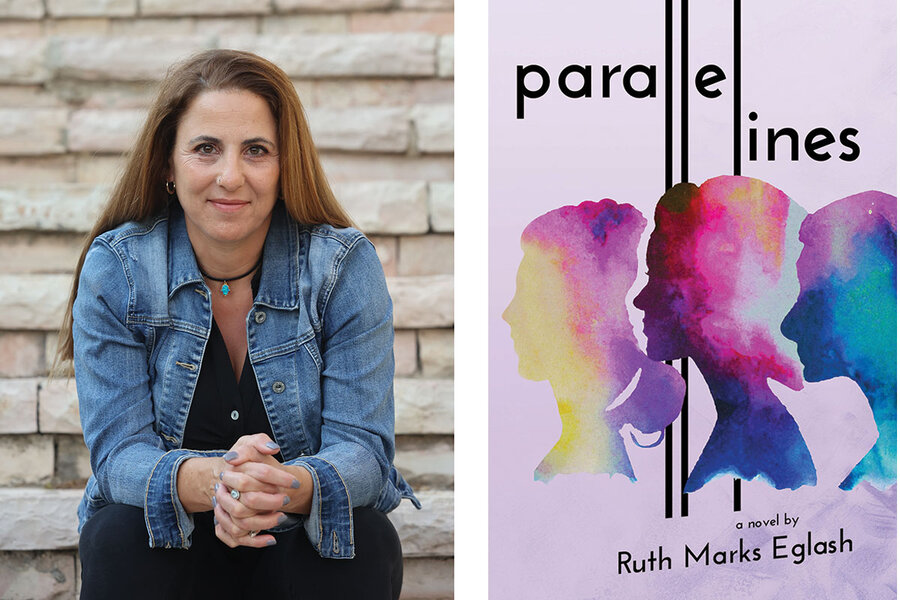To explain Jerusalem’s conflicts, she wrote a young adult novel
Loading...
In her debut novel, “Parallel Lines,” Jerusalem-based journalist Ruth Marks Eglash invites readers behind the headlines of the Israeli-Palestinian conflict. Published over the summer, the young adult tale follows a trio of teenage girls from three distinct worlds – secular Jewish, Haredi (ultra-Orthodox) Jewish, and Palestinian Muslim. Together they navigate the complexities of their shared city of Jerusalem along with the challenges of adolescence. Ms. Eglash, who has reported for The Washington Post and The Jerusalem Post, spoke recently with the Monitor.
Why write a young adult novel?
It was a little bit by accident. I really wanted to explain the Israeli-Palestinian conflict. It’s a bit like a soap opera. I thought, what’s [an easier] way to explain it than through the eyes of young people? At the time, my kids were teenagers. My daughter, Gefen, was going to middle school right in the center of Jerusalem. ... On the one hand, I was writing articles for The Washington Post and explaining [the conflict] on a high level, and then I was explaining it to Gefen on a [different] level. I thought this would be beneficial to everyone else to have it explained in these simple terms.
Why We Wrote This
A well-crafted novel can often portray the humanity of people swept up in conflict zones better than some news reports. Three fictional teenagers in Jerusalem provide an opening for dialogue and change.
The main characters – Tamar, Rivki, and Nour – offer windows into three of Jerusalem’s “tribes.” Which character taught you the most while you were writing?
I think Rivki [the Haredi girl] is fascinating. ... If someone is brought up in the confines of a certain community and all they know is those traditions and that culture, how do they see the world from the outside? ... These “tribes,” as you call them, are very strict; there is no mixing between them. ... So how is there a way for [young people] to interconnect? What makes someone look outside of what they’re being told as a child? What makes someone do something else or think in a different way?
The Israeli-Palestinian situation is like a kaleidoscope of conflicts – grievances, losses, resentments, misunderstandings – that breaks into different patterns almost based on the individual. Does that ring true?
When you hear about the conflict from outside, it seems straightforward: It’s two different groups, and they’re fighting each other. But when you get inside it, it becomes more complicated. It’s not an issue of who’s right and who’s wrong, because everyone is right and wrong. I really wanted to get at the nuances.
Your three protagonists are incredibly resilient. What other qualities did you feel were important for them to demonstrate?
These are young people who are grappling with their teenage angst or issues as any teenager would anywhere. But on top of that, they have to deal with this adult conflict, which is all around them. So, they have no choice. They have to be resilient.
I really wanted to explore this idea that a person can go against the grain – that you’re not necessarily going to follow what your friends are saying, and that you have to come to conclusions by yourself. What influences those decisions? How do we get to a point where young people are militarized? A few of Nour’s friends are, and a few of Tamar’s friends are – they’ve become very militant about issues. And both Nour and Tamar push back. I wanted to explore the idea that a young person could do that ... and not be drawn into the nationalistic arguments that are surrounding them each day. It’s very difficult to do.
You’ve been in Israel for almost three decades. What’s one of the biggest changes you’ve witnessed during that time?
I realized ... that the Oslo Accords were signed exactly 30 years ago, in 1993, and I came [to Jerusalem] a few years after that. There was this euphoria in the mid-to-late ’90s of peace, of a possible solution.
Obviously, that hasn’t worked out. But I think a lot of people still think about that time, especially people my age and older. ... Today, the younger generation that was born during the second intifada, 15 to 20 years ago, they have no recollection of that time. They only grew up with division, with barriers and walls. ... For Israelis, they only see Palestinians carrying out acts of violence, and it’s the same on the other side: The Palestinians only see Israelis as soldiers. The second intifada really took Israelis toward the right, which is what we’re seeing today in the political situation. It also [made] young Palestinians [more extreme]. They’ve lost hope; they’ve given up any hope of having a country.
Do you have hope?
On one hand, I’m not hopeful. I don’t believe there will be a solution as it was envisaged 30 years ago. We’ve moved away from that, and so we need to think again.
But I am hopeful because young people are resilient and can go against the grain. I was very impressed with the young women ... that I met with [for the book]. ... They were smart young women who [understand that] we’re all here living together. The Israelis are here, and the Palestinians are here. No one’s going anywhere. There needs to be a way.







